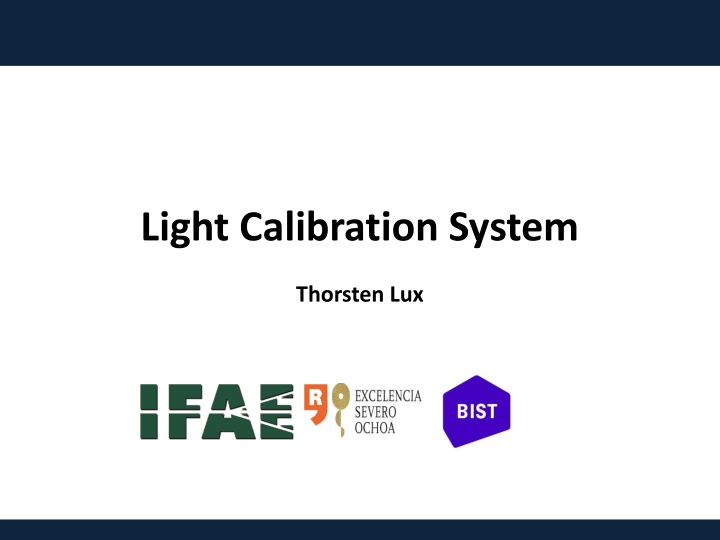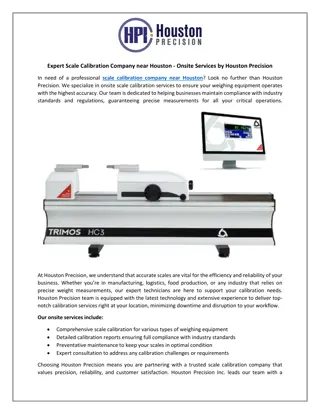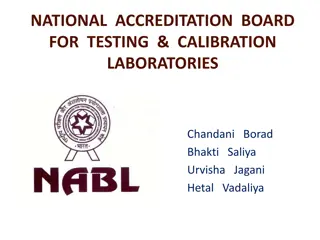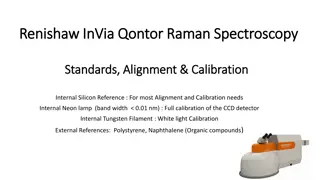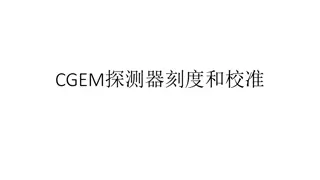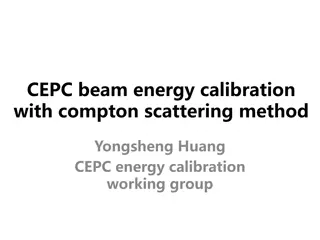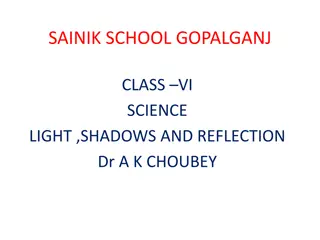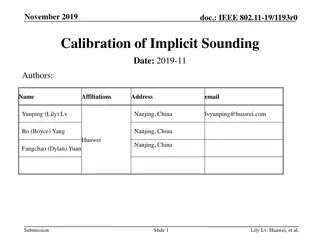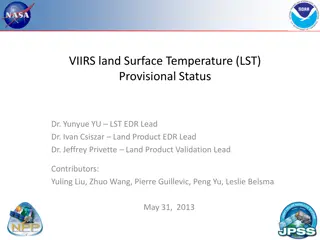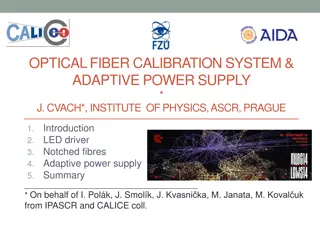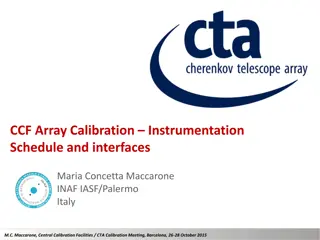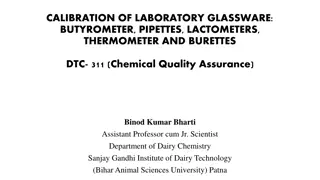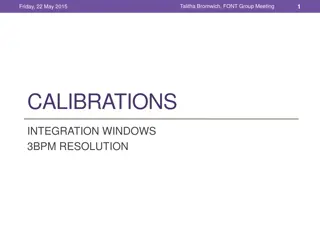Light Calibration System
Utilizing advanced technology, the Light Calibration System by Thorsten Lux offers precise calibration for optimal lighting performance. This innovative system ensures accurate and consistent lighting across various settings, enhancing visual clarity and comfort. With a user-friendly interface and customizable features, the Thorsten Lux system provides a seamless lighting experience for diverse applications.
Download Presentation

Please find below an Image/Link to download the presentation.
The content on the website is provided AS IS for your information and personal use only. It may not be sold, licensed, or shared on other websites without obtaining consent from the author.If you encounter any issues during the download, it is possible that the publisher has removed the file from their server.
You are allowed to download the files provided on this website for personal or commercial use, subject to the condition that they are used lawfully. All files are the property of their respective owners.
The content on the website is provided AS IS for your information and personal use only. It may not be sold, licensed, or shared on other websites without obtaining consent from the author.
E N D
Presentation Transcript
Light Calibration System Thorsten Lux
Overall Conceptual Design X2 Air Black Box Cryostat Inside: Clara s talk 2 weeks ago 2 feedthroughs CF40, each with 3 optical feedthroughs 6 SMA optical fibers from feedthrough to black box black box containing light source black box on top of cryostat 08/03/2025 Thorsten Lux 2
Components Commercial box from Thorlabs: 525 mm x 375 mm x 300 mm (L x W x H) Kaputschinsky LED drivers as light source (https://arxiv.org/ftp/physics/papers/0410/0410281.pdf) Provides fast pulses of few ns Rate: 1 kHz (possible to increase to around 10 kHz) 2 voltages needed: DC between 0 and -20 V for intensity pulsed to trigger light pulse Default LED: NSPB300B (465 nm) (more later) BeagleBoard (BeagleBoard.org) Easy control via ethernet e.g. with Python 8 outputs to provide pulses for Kaputschinsky and also TTL signal for trigger 7 ADC channels e.g. to read temperature sensor 08/03/2025 Thorsten Lux 3
Components SMA-SMA fiber from Thorlabs (1000 um diameter): M59L SMA-SMA feedthrough from Thorlabs: ADASMA Optical fiber on one side LED directly on other side Reference sensor still open point Powermeter seem not to work (see later) Either SiPM or PMT In contact with Cayetano to check if spare readout channel is available to digitize reference sensor Alternative: use ADC of BeagleBoard 08/03/2025 Thorsten Lux 4
Black Box 6 Kaputschinsky LED driver All 6 controlled by 1 BeagleBoard LEDs can be switched on individually, in groups or all together each LED coupled to an individual SMA optical fiber 3 fibers going to one CF40 flange One DC voltage for all 6 Kaputschinsky Kaputschinsky PCB 1 2 Reference Sensor 3 4 BeagleBoard 6 5 Optical fiber 08/03/2025 Thorsten Lux 5
LED Coupling to Optical Fiber Kaputschinsky with blue LED Stray light used for reference sensor PMT/SiPM Black box Optical fiber 08/03/2025 Thorsten Lux 6
Implementation (Conceptual) central reference sensor 6 Kaputschinsky PCBs around each Kaputschinsky with light cavity to guide light to reference sensor material: either 3D printed plastic or aluminium Kaputschinsky PCB Reference Sensor Position of LED adjustable Reference sensor Stray light LED Feedthrough Fiber 08/03/2025 Thorsten Lux 7
Proof-of-Principle Tests Powermeter (measuring light reaching feedthrough) LED reflector Reflective tube Optical fiber PMT 08/03/2025 Thorsten Lux 8
Comparison PMT and Powermeter Signal from PMT compared with signal from powermeter normalized to largest signal similar shape (amplitude of PMT read by eye from oscilloscope => large error) => stray light detected by reference light will allow to estimate injected light to PMTs 1.2 1 0.8 Normalized Signal 0.6 Powermeter 0.4 Reference PMT 0.2 0 0 5 10 15 20 -0.2 LED Bias Voltage [V] 08/03/2025 Thorsten Lux 9
Testing various LEDs Testing various LEDs: 465 nm, 525 nm, 3 of 430 nm the 3 LEDs of 430 nm do not/ almost not work with Kaputschinsky Trying to find other 430 nm LEDs Green LED more power than blue LED 15 nW (blue) correspond to 3.5E10 photons of 465 nm per pulse (1 kHz) reaching the feedthrough on top of the cryostat 45 40 35 30 25 Power [nW] Blue LED (465 nm) 20 Green LED (525 nm) 15 10 5 0 0 5 10 15 20 25 -5 LED Bias Voltage 08/03/2025 Thorsten Lux 10
Time Structure of Light Pulse Old blue LED Old green LED Green LED with longer tail than blue LED New green LED with much longer tail than old green LED (same model) No difference for blue LEDs Pulse width: 15 ns for blue LED New blue LED New green LED 08/03/2025 Thorsten Lux 11
CAD Drawings from Juli drawings from Juli already done small changes to light cavity necessary if Joan agrees on PCB size, soon being printed full system central part flexible so that can be adjusted to SiPM or PMT choice for reference sensor 08/03/2025 Thorsten Lux 12
CAD Drawings from Juli 08/03/2025 Thorsten Lux 13
Summary The light calibration system be based on 6 Kaputschinsky LED driver Blue LED (465 nm) default choice currently BeagleBoard will allow to control drivers (individually, groups, all together) 1 reference sensor: SiPM or PMT Either standard ADC to digitize signal or built-in ADC Simplified test of the principle performed successfully Most of the commercial parts ordered Production drawings in process for light cavity and LED driver PCB MWPC: CO2 gas will arrive this week, mixture in 3 weeks DNA Setup: will try to use EL PMTs to avoid noise ripple 08/03/2025 Thorsten Lux 14
